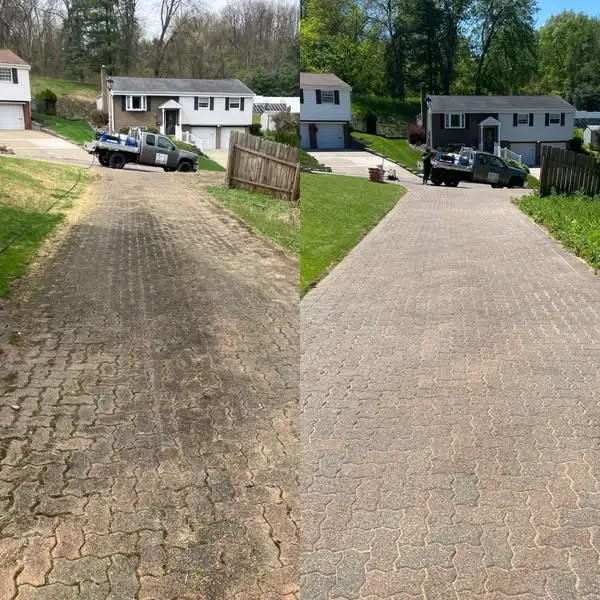Concrete is a durable and versatile material commonly used for driveways, walkways, patios, and other outdoor surfaces. However, its longevity and appearance can be significantly enhanced by applying a sealer. In this blog post, we’ll explore the advantages of sealing concrete and discuss scenarios where sealing makes sense and when it might not be necessary.
Advantages of Sealing Concrete
1. Protection from the Elements
Concrete is porous, meaning it can absorb water and other substances. Over time, exposure to rain, snow, ice, and UV rays can cause the concrete to crack, spall, or become discolored. Sealing concrete creates a protective barrier that helps repel water and prevent damage from freeze-thaw cycles, reducing the risk of cracks and surface wear.
2. Enhanced Appearance
A good sealer can enhance the color and texture of concrete, making it look more vibrant and appealing. Sealers come in a variety of finishes, from matte to high gloss, allowing you to choose the look that best suits your aesthetic preferences. They can also bring out the natural beauty of decorative concrete, such as stamped or stained surfaces.
3. Stain Resistance
Unsealed concrete can easily absorb oil, grease, chemicals, and other staining agents, leading to unsightly blemishes that are difficult to remove. Sealing creates a non-porous surface that resists stains and makes cleaning spills much easier. This is particularly beneficial for driveways and garage floors, where oil and chemical spills are common.
4. Extended Lifespan
By protecting against moisture, chemicals, and surface wear, sealing can significantly extend the lifespan of concrete surfaces. This reduces the need for costly repairs or replacements, making sealing a cost-effective investment in the long run.
5. Stays Cleaner Longer
Sealing concrete can help prevent the growth of mold, mildew, and algae, especially in areas with high humidity or frequent rainfall. These organisms thrive in moist environments and can cause the concrete to become slippery and hazardous. A sealed surface remains drier and less hospitable to these unwanted growths. In addition, sealed concrete takes longer to absorb dirt and therefore extends the time the concrete stays clean
When to Seal Concrete
1. Newly Poured Concrete
New concrete should be sealed after it has fully cured, typically around 28 days after pouring. Sealing helps protect the fresh surface from early exposure to the elements and stains.
2. High-Traffic Areas
Driveways, walkways, patios, and pool decks are subjected to constant foot and vehicle traffic. Sealing these surfaces can protect them from wear and tear, extending their usability and maintaining their appearance.
3. Decorative Concrete
If you have invested in decorative concrete finishes, such as stamping, staining, or exposed aggregate, sealing is essential to preserve their look and prevent color fading and surface degradation.
4. Areas Prone to Moisture and Stains
Locations that are frequently exposed to water, oil, grease, or chemicals should be sealed to prevent staining and damage. Garage floors, outdoor kitchens, and pool decks are prime candidates for sealing.
When Not to Seal Concrete
1. Low-Traffic Areas
For concrete surfaces that are not frequently used or exposed to harsh conditions, such as garden pathways or seldom-used patios, sealing may not be necessary. The cost and effort of sealing might outweigh the benefits in these cases.
2. Concrete with Existing Coatings
If your concrete surface already has a coating, such as paint or another type of sealer, adding another layer might not provide additional benefits and could potentially cause peeling or flaking. It’s important to consult a professional to determine the best course of action for recoating.
3. Natural Weathering Preference
Some homeowners prefer the natural weathered look of unsealed concrete. If aesthetics are a priority and you appreciate the aged patina that develops over time, you might opt to leave the concrete unsealed.
4. Old/Cracked Concrete
If your concrete is decades old, has cracks the size of the Grand Canyon, and/or has exposed aggregate (unless that’s the look you’re aiming for) we do not recommend sealing it. While washing it will still make it look significantly better, the purpose of the sealer is to prevent cracks/deterioration, and of you check the above boxes it might be to late for that.
Conclusion
Sealing concrete offers numerous advantages, from enhancing its appearance and stain resistance to protecting it from the elements and extending its lifespan. However, the decision to seal should be based on the specific conditions and usage of the concrete surface. For high-traffic areas, decorative finishes, and locations prone to moisture and stains, sealing is highly recommended. In contrast, low-traffic areas, surfaces with existing coatings, or old, cracked concrete might not require sealing.
If you’re unsure of what’s right for you and are in the Pittsburgh area, CC Pressure Washing is here to help. Feel free to fill out our online form or call/text us at 412-327-7411 for a same-day response


